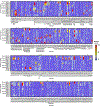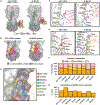High-throughput synthesis and specificity characterization of natively paired influenza hemagglutinin antibodies with oPool+ display
- PMID: 40901925
- PMCID: PMC12422562
- DOI: 10.1126/scitranslmed.adt4147
High-throughput synthesis and specificity characterization of natively paired influenza hemagglutinin antibodies with oPool+ display
Abstract
Antibody discovery is crucial for developing therapeutics and vaccines and for understanding adaptive immunity. However, the lack of approaches to synthesize antibodies with defined sequences in a high-throughput manner represents a major bottleneck in antibody discovery. Here, we present oPool+ display, a high-throughput cell-free platform that combined oligo pool synthesis and mRNA display to rapidly construct and characterize hundreds to thousands of natively paired antibodies in parallel. As a proof of concept, we applied oPool+ display to probe the binding specificity of more than 300 uncommon influenza hemagglutinin-specific antibodies against nine hemagglutinin variants through 16 screens. More than 5000 binding tests were performed in 3 to 5 days of hands-on time with further scaling potential. Follow-up structural and functional analysis of two antibodies revealed the versatility of the human immunoglobulin gene segment D3-3 (IGHD-3-3) in recognizing the hemagglutinin stem. Overall, this study established an experimental platform that not only accelerates antibody characterization but also enables unbiased discovery of recurring molecular signatures among antibodies with the same specificity.
Conflict of interest statement
DECLARATION OF INTERESTS
N.C.W. consults for HeliXon. The authors declare no other competing interests.
Figures






Update of
-
High-throughput synthesis and specificity characterization of natively paired antibodies using oPool+ display.bioRxiv [Preprint]. 2025 Feb 28:2024.08.30.610421. doi: 10.1101/2024.08.30.610421. bioRxiv. 2025. Update in: Sci Transl Med. 2025 Sep 3;17(814):eadt4147. doi: 10.1126/scitranslmed.adt4147. PMID: 39257766 Free PMC article. Updated. Preprint.
References
-
- Pedrioli A, Oxenius A, Single B cell technologies for monoclonal antibody discovery. Trends Immunol. 42, 1143–1158 (2021). - PubMed
-
- Valldorf B, Hinz SC, Russo G, Pekar L, Mohr L, Klemm J, Doerner A, Krah S, Hust M, Zielonka S, Antibody display technologies: selecting the cream of the crop. Biol. Chem 403, 455–477 (2022). - PubMed
-
- Sheets MD, Amersdorfer P, Finnern R, Sargent P, Lindquist E, Schier R, Hemingsen G, Wong C, Gerhart JC, Marks JD, Efficient construction of a large nonimmune phage antibody library: the production of high-affinity human single-chain antibodies to protein antigens. Proc. Natl. Acad. Sci. U. S. A 95, 6157–6162 (1998). - PMC - PubMed
MeSH terms
Substances
Grants and funding
LinkOut - more resources
Full Text Sources
Research Materials

